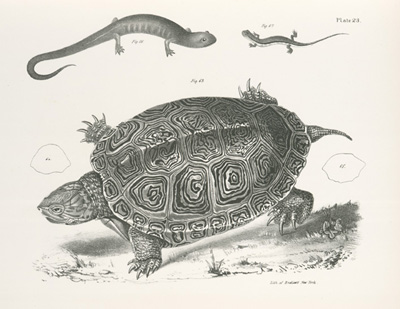

• Intro / Home
• Historical Neighbors
• Street and Backyard
Neighbors
• Park and Green Places
Neighbors
• Shore and Wetlands
Neighbors
• Salt and Freshwater
Neighbors
• Tiny Neighbors
• Unwelcome Neighbors
• Occasional and
Unexpected Neighbors
•
Wildlife Sighting Log
• Resources
• Hours and Tours
• Press Release
• NYPL HOME
| Shore and Wetlands Neighbors | |
 |
||
|
|
James Ellsworth DeKay (1792–1851) erroneously gave the same turtle two names in the reptile volume of his historic study. Here, an individual reportedly found in fresh water on Long Island is identified as the "Smooth Terrapin," while another Diamondback is described as a "Salt-water Terrapin." Actually, Diamondback Terrapins, who feed on a variety of crustaceans, fish, insects, and mollusks, inhabit salt marshes and are the only turtles who live in this brackish environment. Females can reach 8 inches in length, and are twice the size of the males. A popular taste for turtle soup in the late 19th and early 20th centuries decimated their numbers, but protective legislation has enabled Diamondbacks to slowly rebuild their populations. Unfortunately, they are at risk again, by collection for food use. Check out the sighting log to record your interaction with some of the native New York City wildlife, such as the Diamondback Terrapin, featured in Urban Neighbors. You may also browse the sighting log by animal, borough, park or natural area, and/or habitat to view a sighting you have submitted or to read others’ observations.
|